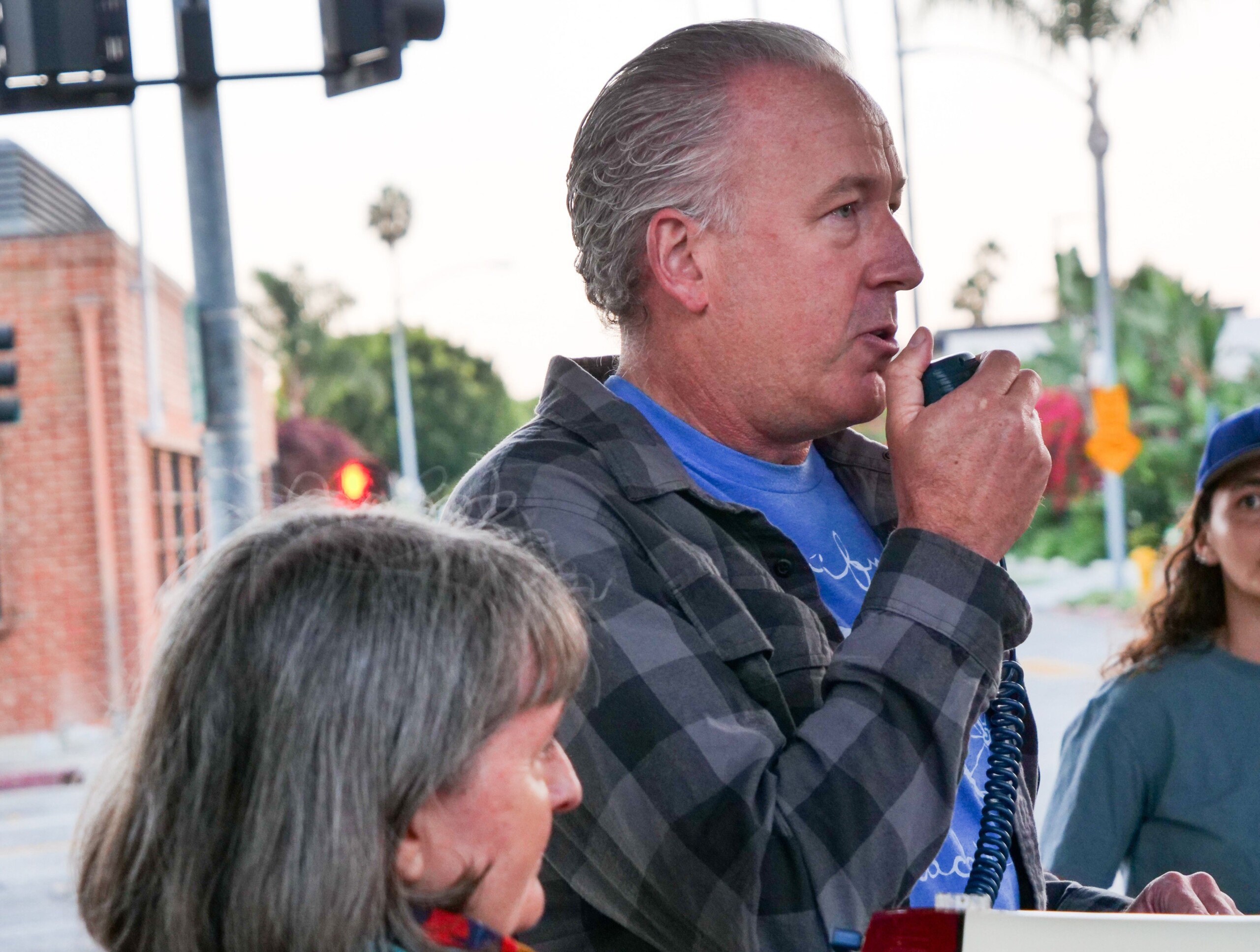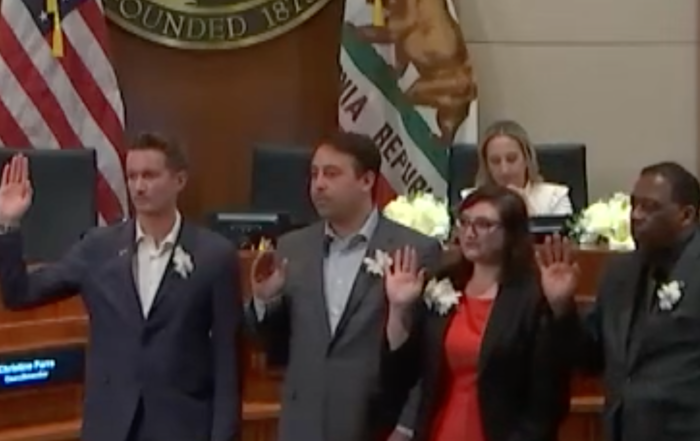There’s still a stain of Phoebe Kiekhofer Garfinkel’s blood on the street where she was hit by a truck.
A member of the nonprofit Bike Culver City, Garfinkel was one of several speakers at a vigil held by the organization Monday night. In response to a recent fatality on a major Culver City street, demonstrators and advocates gathered at the intersection of National Boulevard and Wesley Street before marching to City Hall to demand street safety improvements in the area and beyond.
Garfinkel was not hit at the National/Wesley intersection but felt it was important to speak on her experiences with traffic accidents. She was hit while riding her bike in August, causing severe bleeding, multiple broken ribs, and creating gaps in her memory.
“People who heard the crash said it was so loud, they thought it was two cars,” Kiekhofer said. “When people saw my body in the street surrounded by blood, they thought that I had died.”
A pedestrian was killed in a vehicle collision on September 30 near the spot where demonstrators stood, which was particularly concerning to Bike Culver City because many children use the National Boulevard and Wesley Avenue intersection while walking to school.
This is one chapter in a history of accidents that have increased in the past two months. A cyclist was involved in a hit-and-run accident at the intersection on September 11, and there was a two-vehicle crash reported by a resident last Thursday.
These conditions are unacceptable for the biking advocates present, including Bike Culver City member David Coles, who argued that street design decisions like lenient speed limits were the main factor that caused these accidents. He says he worries about his kids when they leave the house because of how dangerous streets still are for pedestrians.
“This road is doing exactly what it is designed to do: to make it easy for people in cars to shoot through neighborhoods,” Coles said. “There’s so much talk about public safety…traffic violence is a huge threat to public safety.”
Former Culver City Mayors Meghan Sahli-Wells and Alex Fisch also spoke to the audience at the vigil Monday night. Both were staunch advocates for safer mobility policy during their tenures on the council and expressed dismay over the recent collisions.
Fisch invoked the story of journalist Vic Langenhof and the transformation of the streets in the Netherlands into those reflective of a cycling culture. On October 14, 1971 — exactly 53 years before Monday’s demonstration — 6-year-old Simone Langenhoff was killed by a driver while cycling to school in the village of Helvoirt, about 60 miles south of Amsterdam.
“The police report in that incident would have said that speed is not a factor and the driver was not impaired,” Fisch said. “That didn’t save Simone’s life.”
The editorial that the elder Langenhof wrote in response to her death kicked off the Stop de Kindermoord movement, which translates to “Stop the Child Murder.” At that time, the Netherlands was experimenting with the same urban design the United States has been carrying out since World War II, according to Fisch.
Dutch street planning shifted its philosophy and approached the city with a mindset far less dependent on driving, resulting in a system that had just 683 traffic fatalities in 2023. He contrasted this with the United States, which he argues uses “pseudoscience that has never taken the safety of non-drivers seriously.”
“You can dig in and find out yourself,” Fisch said of the planning science, “and you will be horrified.”
Sahli-Wells spoke of her sadness that Culver City is still unsafe for pedestrians in many areas and instances despite her efforts. She lamented that efforts in recent years to make the city safer like the MOVE Culver City effort were being derailed and pedestrians were still dying.
“I am speechless because in my own neighborhood, the ounce of progress we made is being scraped away,” Sahli-Wells said. “It took so many years, it took so many plans, it took tens of thousands of hours of public outreach.”
She also highlighted the continued gravity of the problem — with about 41,000 traffic fatalities in 2023 according to estimates from the National Highway Traffic Safety Administration.
“The population of Culver City is 40,000,” Sahli-Wells said. “That is the entire city and more being wiped off the face of the Earth.”
Bike Culver City Vice President David Metzler summed up the group’s motive succinctly in his remarks at the demonstration, stating that people simply want to be safe when they move around the city.
“We don’t expect everyone to bike,” Metzler said, “but we expect everyone who bikes to be able to make it home alive.”
After the speakers rallied the small crowd, the group walked on foot with bikes in tow from the intersection to City Hall. There, several advocates also made comments at that night’s city council meeting pleading for safe street infrastructure.
Culver City Council candidate Bubba Fish was one of those advocates. He pointed out the lack of changes on the National/Wesley intersection despite being the site of multiple fatalities over the past two decades.
“Traffic violence is not an inevitable fact of life,” Fish said. “It is both predictable and preventable.”
Photo of Alex Fisch taken by the author.
Stay informed. Sign up for The Westside Voice Newsletter
By clicking submit, you agree to share your email address with Westside Voice. We do not sell or share your information with anyone.








